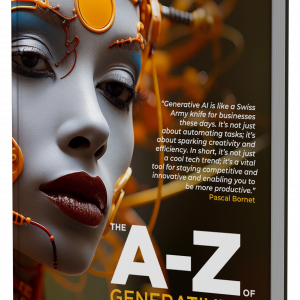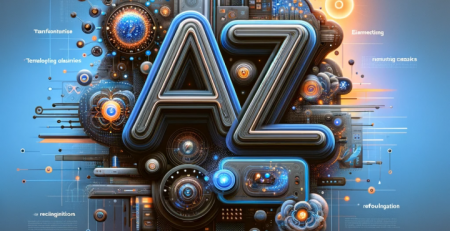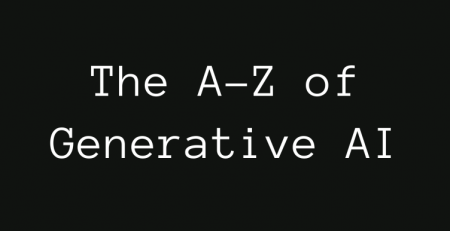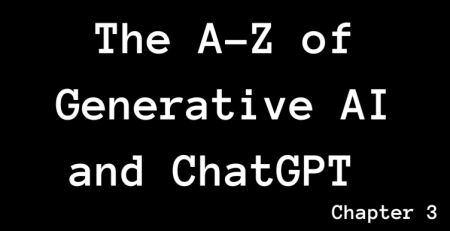The A-Z of Generative AI and ChatGPT – Chapter S
Welcome to ‘The A-Z of Generative AI and ChatGPT – Chapter S’, where we delve into the fascinating world of social media, supervised learning and other generative AI concepts beginning with the letter S, which provide valuable insights into how AI can create new content, solve problems, and drive innovation.
Implementing Custom Large Language Models
“Generative AI is remarkably powerful for organizations. A significant use case involves the development of an internal Large Language Model (LLM) that allows employees to ask questions.
The model has access to the company’s data and understands permissions and privacy, ensuring that information is only revealed to authorized individuals.
Naturally, trust is a crucial concern for organizations regarding data. This is why instead of sharing data with public LLMs, open-source LLMs can be deployed, supervised, and offer fine-tuning and control capabilities that appeal to many organizations.”
Enhancing Sales Processes with ChatGPT
In a market where CEOs are always looking for effective ways to boost their sales processes, ChatGPT emerges as a powerful tool. So, let me introduce five ChatGPT prompts to you, each carefully designed to enhance different stages of the sales cycle. These prompts aim to optimize and add precision to your sales strategies, from generating new prospects to engaging with tradeshow contacts.
Let’s dive into how ChatGPT can level up your sales game.
- Generating Prospecting Ideas – ChatGPT and generative AI can assist you in brainstorming fresh prospecting ideas, allowing you to develop highly tailored approaches to potential clients in a way that truly stands out.
Sample prompt: “ChatGPT, provide me with a list of innovative prospecting strategies for [industry/type of product or service]. Include both digital and traditional sales methods.” - Crafting Follow-Up Emails – Generative AI can ensure your follow-up emails are not just timely but also crafted to maintain a prospect’s interest and lead them towards the next step in the buying journey.
Sample prompt: “ChatGPT, can you draft a follow-up email for a prospect who showed interest in our [specific product/service] during our last meeting? The tone should be engaging yet professional and include a call to action for a follow-up meeting.” - Rewording Proposal Documents – With this prompt, ChatGPT helps refine your proposal language, making it more effective and aligned with the client’s needs and expectations.
Sample prompt: “ChatGPT, reword the following paragraph [‘insert paragraph’] from a sales proposal and make it more persuasive [use template attached to help guide, but not constrain, your response] and client-focused [details of ideal client persona] .The goal is to highlight the benefits of buying the service and its unique value to the client.” - Answering Common Client Queries – Generative AI can help answer common customer or supplier queries, enabling better, faster, and more consistent responses.
Sample prompt: “Provide clear and concise answers for these common client questions [List questions] about our. The answers should be informative, persuasive, and reassure the client of our immense value.” -
- Crafting Tradeshow Follow-Up Strategies – Generative AI helps you create a tailored follow-up action plan for each lead you gather at an event or tradeshow. It ensures that the initial interest is nurtured into a potential sale opportunity by adding a personal touch that reflects your interactions at the event and your brand.
Sample prompt: “Suggest ten follow-up actions for contacts we met at the [ Event / Tradeshow & Purpose of the Event]. Include personalized email template ideas with engaging content to share and strategies for setting up meetings and product demos. “
Revolutionizing Social Media with ChatGPT
ChatGPT, powered by advanced generative AI, is also revolutionizing social media content creation and communication. From shaping online trends to personalizing user experiences, ChatGPT is transforming social media in lots of ways:
- Content Creation: Generative AI has made it easier to produce content, from text posts and articles to images and videos, helping brands and individuals maintain a consistent, attention-grabbing online presence.
Practical Example: A digital marketing agency uses generative AI to create varied content for their clients’ social media. They input basic themes or keywords, describe their audience, ideal client profile (ICP) and products/services, and the AI generates engaging blog posts, articles, catchy social media captions, and even initial attention-grabbing graphic designs for [ICP].
Sample Prompt: “Generate a series of [X] engaging Instagram captions for a [NAME] travel agency focusing on eco-friendly tourism to [location].” Afterwards, you can even assess the effectiveness of your posts ‘”Assess and analyze the effectiveness of the following post [hyperlink/text] targeted at [target audience].” - Personalization: AI algorithms can analyse user data to personalize content, ensuring users see social media marketing posts aligned with their interests to drive engagement and encourage them to spend more time on social platforms.
Practical Example: An online video streaming service uses AI to analyze users’ watch history and preferences to suggest personalized content to viewer feeds to encourage them to spend more time on their video streaming platform.
Sample Prompt: “Analyse user viewing streaming history to curate a personalized list of movie recommendations for [customer] social media feed.” - Customer Interaction: Chatbots like ChatGPT are used for customer service and engagement on social media platforms. They can handle inquiries, provide information, and even entertain users, offering a 24/7 service that wasn’t feasible before.
Practical Example: An e-commerce company employs a ChatGPT-powered bot on their Facebook page. The AI bot intelligently answers customer queries about products, provides shipping information, and even assists with order placement, enhancing customer service efficiency.
Sample Prompt: “Assist [customer] in finding the perfect birthday gift from our online store, providing options based on their [list] of preferences.” - Trend Analysis and Prediction: Generative AI can analyse vast amounts of data to identify and predict trends. This helps businesses and content creators to align their strategies with emerging trends.
Practical Example: A fashion brand uses generative AI to analyse social media trends using sentiment analysis (see further below) to predict potential upcoming fashion trends. This analysis helps them to design their next collection, aligning it with predicted trends to increase its market appeal.
Sample Prompt: “Identify emerging summer fashion trends for 2024 based on current social media data from [platform X] from [Date X – Y].” - Language Translation and Accessibility: AI has improved language translation services, making content accessible to a wider global audience, reducing language barriers, and expanding the reach of social media content.
Practical Example: A multinational company uses AI-driven translation tools to automatically translate their social media posts into multiple languages, making their content accessible to a diverse global audience and expanding their market reach.
Sample Prompt: “Translate our latest social media campaign into Spanish, French, and Mandarin, ensuring cultural relevance and accuracy in each language.”
ChatGPT and generative AI are transforming social media. They are not just reshaping our digital interactions but making them more dynamic, accessible, and effective. As we learn to harness these technologies, we step into a future where digital communication is more responsive, inclusive, and innovative, marking a new era in how we connect and engage online.
Sentiment analysis
Sentiment analysis involves determining the emotional tone behind words to understand a speaker or writer’s attitudes, opinions, and emotions. It is commonly used in CRM to understand customer feedback or social media conversation about a brand or product. It can be prone to algorithmic bias since language is inherently contextual. It’s difficult for humans to detect sarcasm in written language, so gauging tone is subjective.
- What it means for customers: Customers can offer feedback through new channels, leading to more informed decisions from the companies they interact with.
- What it means for teams: Sentiment analysis can be used to understand how customers feel about a product or brand based on their feedback or social media posts, which can inform many aspects of brand or product reputation and management.
Keen to learn more❓ Then keep reading.
Sentiment Analysis in CRM and Social Media Engagement
Sentiment analysis involves determining the emotional tone behind words to understand a speaker or writer’s attitudes, opinions, and emotions. It is commonly used in CRM to understand customer feedback or social media conversation about a brand or product. It can be prone to algorithmic bias since language is inherently contextual. It’s difficult for humans to detect sarcasm in written language, so gauging tone is subjective.
- What it means for customers: Customers can offer feedback through new channels, leading to more informed decisions from the companies they interact with.
- What it means for teams: Sentiment analysis can be used to understand how customers feel about a product or brand based on their feedback or social media posts, which can inform many aspects of brand or product reputation and management.
Keen to learn more? Then keep reading.
Enhancing Creative Storytelling with ChatGPT
There are a wide variety of prompts that can be used. One thing people love is stories, so why not consider using ChatGPT to create stories?
For example, ‘Guide me in exploring the Rashomon Effect in storytelling. Explain the concept from various perspectives and how to portray them in a narrative. Highlight its capacity to explore the subjectivity of trust and differing perspectives.’
Or ‘Guide me in understanding the three-act structure of storytelling. Explain the key components of each act and provide examples of how to structure a story accordingly. Highlight the main benefit of creating a well-paced and engaging narrative.’
Now, ‘act as a short adventure writing and use the three-act structure of the storytelling model to craft a story with a surprising twist ending that leaves a lasting impact on readers. The story’s topic is ‘how businesses can use LinkedIn to sell more concrete. The complete story should be 500 words or less.’
The more you practice and train ChatGPT, the more you will benefit. So, get practising and get training.
Leveraging Supervised Learning for Business Strategy
How do you train ChatGPT to deliver better results? Just like you provide feedback to an intern or new hire, you must provide examples (e.g., documents, case studies, sample emails, articles, previous correspondence, etc.) and tell ChatGPT if it has given you a good answer or a bad answer, i.e., supervised learning.
Supervised learning is when a model learns from examples. It’s like a teacher-student scenario: the teacher provides the student (the model) with questions and the correct answers. The student studies these and, over time, learns to answer similar questions independently.
- What it means for customers: Systems that learn to understand better customer needs from every past interaction, e.g., think generative AI-infused conversational AI customer service chatbots.
- What it means for teams: Businesses can better predict customer behaviour or segment customers into groups based on past data. For example, an insurance broker can better determine a customer’s propensity to remain with the business based on their price sensitivity. Those customers who are extremely ‘sticky’ with a ‘high customer lifetime value’ could be charged more money at insurance renewal as the company knows they are more likely to stay. This could increase company revenue and profits. More ‘flighty’ customers could be offered better deals to stay.
Letter S
Understanding the A-Z of Generative AI opens up a rich world of possibilities for business leaders. These concepts provide valuable insights into how AI can create new content, solve problems, and drive innovation across various industries.
1. Self-Supervised Learning in Generative AI 🆂
Self-supervised learning in Generative AI is a training method where AI models learn from the data itself without explicit human annotations. It’s like a student learning independently from a textbook without a teacher’s guidance. Self-supervised learning allows AI models to leverage the inherent structure and patterns within the data to improve content generation.
For Example: An AI language model learns by predicting missing words in a sentence, acquiring a deeper understanding of language patterns.
Prompt: “ChatGPT, embrace self-supervised learning to enhance your content generation capabilities, learning directly from the data to provide more contextually relevant responses.”
2. Sequence-to-Sequence Models in Generative AI 🆂
Sequence-to-Sequence Models in Generative AI are architectures that take an input sequence and produce an output sequence. It’s like translating a sentence from English to French. Sequence-to-sequence models are highly versatile and are widely used in tasks like machine translation and text summarization.
For Example: An AI chatbot uses sequence-to-sequence models to understand user queries and respond with coherent and relevant answers.
Prompt: “ChatGPT, leverage sequence-to-sequence models to improve your content generation, effectively processing input sequences and generating corresponding responses.”
3. Style Transfer in Generative AI 🆂
Style Transfer in Generative AI involves transforming the style of content while preserving its underlying structure. It’s like taking a painting and applying the style of a famous artist to it. Style transfer enables AI models to generate content in various artistic styles or adapt to different writing tones.
For Example: An AI image generator transfers the artistic style of famous painters to input images, creating unique and visually appealing artwork.
Prompt: “Create an engaging and informative presentation on ‘Style Transfer in Generative AI’ for a workshop aimed at artists and graphic designers. Start with an introduction slide explaining the concept of style transfer, likening it to reimagining a painting with the stylistic elements of a different famous artist. Include slides that visually demonstrate how this technology works, perhaps showing a standard image and its transformations using the styles of various renowned artists.
Dedicate a section to discussing the technical underpinnings of style transfer in AI, such as convolutional neural networks and deep learning algorithms. Incorporate case studies or real-world examples where style transfer has been used creatively in art and design, highlighting its potential for innovation in these fields. Add a slide discussing the future possibilities of style transfer in AI, including its potential applications in industries such as fashion, interior design, and advertising. Ensure the presentation is visually rich and interactive, possibly including live demonstrations or interactive elements where participants can see style transfer in action using an AI tool.”
4. Storytelling with Generative AI 🆂
Storytelling with Generative AI is the ability to create coherent and engaging narratives using AI models. It’s like having an AI co-author to help with creative writing. Storytelling AI can be applied to generate personalized narratives, interactive storytelling, and content for video games.
For Example: An AI-powered interactive storytelling platform generates immersive and personalized stories based on user choices.
Prompt: “ChatGPT, master the art of storytelling to create captivating narratives, immersing users in personalized and interactive experiences.”
5. Scalability in Generative AI 🆂
Scalability in Generative AI refers to the ability of AI models to handle large-scale data and content generation tasks. It’s like efficiently processing millions of documents simultaneously. Scalability ensures that AI models can handle high volumes of content generation requests without compromising quality or speed.
For Example: An AI content generator can handle content requests from thousands of users simultaneously without a drop in performance.
Prompt: “ChatGPT, demonstrate scalability in your content generation, efficiently processing a large number of queries while maintaining the same level of accuracy and efficiency.”
6. Simulated Environment Training in Generative AI 🆂
Simulated Environment Training in Generative AI involves training AI models in simulated environments that mimic real-world scenarios. It’s like pilots training in flight simulators before flying a real plane. Simulated environment training enables AI models to learn from diverse experiences without real-world risks.
For Example: An AI-driven virtual car learns to drive in various simulated environments before being tested on real roads.
Prompt: “ChatGPT, benefit from simulated environment training to enhance your content generation capabilities, gaining valuable experience in diverse scenarios.”
7. Semantic Segmentation in Generative AI 🆂
Semantic Segmentation in Generative AI is the process of labelling each pixel in an image with a corresponding class label, capturing the semantic meaning of the scene. It’s like colouring different objects in a colouring book according to their categories. Semantic segmentation allows AI models to generate more contextually accurate and detailed content for images.
For Example: An AI image generator uses semantic segmentation to ensure generated images contain objects with correct boundaries and labels.
Prompt: “ChatGPT, explore semantic segmentation to improve your image content generation, producing more contextually accurate, photo realistic, and meaningful visuals.”
8. Sentiment Analysis in Generative AI 🆂
Sentiment Analysis in Generative AI involves determining the emotional tone or sentiment expressed in text or other content. It’s like detecting the emotions conveyed in a customer’s feedback. Sentiment analysis enables AI models to generate content that is sensitive to the emotions of users, creating more empathetic responses.
For Example: An AI customer support agent uses sentiment analysis to tailor responses based on the customer’s emotions and needs.
Prompt: “ChatGPT, incorporate sentiment analysis in your content generation to provide empathetic responses, considering users’ emotional states in your answers [input file].”
Understanding the A-Z of Generative AI opens up a rich world of possibilities for business leaders. These concepts provide valuable insights into how AI can create new content, solve problems, and drive innovation across various industries. Embracing Generative AI can lead to enhanced creativity, improved decision-making and a competitive edge in the rapidly evolving data-infused digital landscape.
Productivity Prompts
Generative AI will impact every single role you can think of. Understanding how to interact with ChatGPT will soon be an essential key skill.
Below are five roles that begin with the letter S with an example prompt, each massively boosting role productivity.
Software Engineer. Software engineers design, develop, and test computer software and applications.
- Prompt: Develop a coding standard for the team to ensure consistent and clean code.
- Prompt: Implement automated testing to detect and fix bugs in the software development process.
Sales Manager. Sales managers lead sales teams, set targets, and develop sales strategies.
- Prompt: Conduct sales training workshops to improve the team’s selling skills.
- Prompt: Analyze sales data to identify trends and opportunities for increased sales [Upload sales data file].
Social Media Manager. Social media managers oversee an organization’s social media presence and engagement.
- Prompt: Create a content calendar for social media posts to ensure consistent posting.
- Prompt: Monitor social media analytics to measure the effectiveness of social media campaigns.
Systems Analyst. Systems analysts analyze and design information systems to meet business needs.
- Prompt: Conduct a systems audit to identify areas for improvement and efficiency.
- Prompt: Collaborate with stakeholders to gather requirements and develop system specifications.
Supply Chain Manager. Supply chain managers oversee the entire supply chain process, from sourcing to delivery.
- Prompt: Implement supply chain analytics to optimize inventory management.
- Prompt: Develop contingency plans for potential supply chain disruptions.
Generative AI – Research Articles
Some of the best Generative AI articles from some of the best sources on the internet.
- BCG How People Create and Destroy Value with Generative AI
- ERP Today Generative AI for the enterprise – Pascal BORNET and Kieran Gilmurray
- BCG AI at Work: What People Are Saying
- How Generative AI Is Forging Productivity in Sales and Marketing | Bain & Company
- OpenAI Prompt engineering – OpenAI API
- GenAI and the Path to Profit in B2B Sales | BCG
- Ready for Launch: How Gen AI Is Already Transforming Marketing | Bain & Company
- SSRN: Navigating the Jagged Technological Frontier: Field Experimental Evidence of the Effects of AI on Knowledge Worker Productivity and Quality
- BCG Responsible AI is Crucial to Avoid New AI Tech Risks
Get to Know Me!
I am a senior executive with 28+ years of experience leading artificial intelligence and digital programs and I am the author of “The A-Z of Organizational Digital Transformation.” I have been a director, board member, research fellow, and advisor to multiple international companies.
Find me on social LinkedIn | Kieran Gilmurray | Twitter | YouTube | Spotify | Buzzsprout

I am regularly ranked as one of the top global experts in Artificial Intelligence, Intelligent Automation, Data Analytics, Brand Influence, and Business Technology Innovation and have won multiple international awards, including:
🔹Top 14 people to follow in data in 2023
🔹Top 20 Data Pros you NEED to follow
🔹World’s Top 200 Business and Technology Innovators
🔹Global Automation Award Winner
🔹Top 50 Intelligent Automation Influencers
🔹Top 50 Brand Ambassadors

I am a hugely experienced data science leader who has led teams of Ph. D.s, data analysts, data engineers, and database administrators for many years, creating one of the few genuine decision intelligence companies to date along the way.
Check out my previous article – The A-Z of Generative AI and ChatGPT – Chapter R – Kieran Gilmurray












Leave a Reply